Specimen of the Week: Week 154
By Dean W Veall, on 22 September 2014
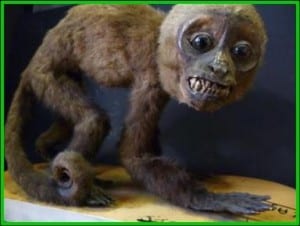 Hello new readers, occasional fans and dedicated followers of Specimen of the Week. Dean Veall here. My other specimens here have been all about the underdog, the specimens that do not get much attention because they are of the invertebrate persuasion or are stuffed away in a drawer. But this week I am breaking away from this and going all out popular with a specimen that features heavily in our promotional material and one loved by our visitors, selling out, some might suggest. To those people I say no. No, I am staying true to my beliefs with this week’s specimen. This specimen although popular is very much a minority within our collection it’s just one of only 73 taxidermy specimens we have in a collection of 68,000 and it is one that represents a group that has been terribly misunderstood taxonomically.
Hello new readers, occasional fans and dedicated followers of Specimen of the Week. Dean Veall here. My other specimens here have been all about the underdog, the specimens that do not get much attention because they are of the invertebrate persuasion or are stuffed away in a drawer. But this week I am breaking away from this and going all out popular with a specimen that features heavily in our promotional material and one loved by our visitors, selling out, some might suggest. To those people I say no. No, I am staying true to my beliefs with this week’s specimen. This specimen although popular is very much a minority within our collection it’s just one of only 73 taxidermy specimens we have in a collection of 68,000 and it is one that represents a group that has been terribly misunderstood taxonomically.
This week’s Specimen of the Week is…
**The Elephant Shrew**
1). What’s in a name?
With a long tubular snout protruding from the skull, these small insectivorous mammals native to Africa were thought to resemble elephants and were given the imaginative moniker of elephant shrew. But more recently there has been a move away from that name in favour of the one proposed by African wildlife expert Johnathan Kingdon, the Swahili word sengi. Species of sengi can range in size from the small Namib round-eared sengi (Macroscelides flavicaudatus) weighing around 28g to the recently discovered grey-faced sengi (Rhynchocyon udzungwensis) that weighs over 700g. Our specimen is a particularly large individual that measures in length a whopping 48cm from nose to tail. That long nose that the sengi is incredibly sensitive and is perfect for locating and sensing its prey, which include invertebrates such as ants, millipedes and spiders. Unlike elephant trunks the snout of the sengi is not as flexible and contrary to popular belief it’s nose is not prehensile with the sengi unable to use it to pick anything up. In fact the snout appears to be awkward and cumbersome when attempting to catch prey, similar to anteaters the sengi uses a long sticky tongue to catch insects, but is forced to shoot it out at the side of it’s mouth to avoid the nose at the front.
2). Sir Chris Hoy.
Now what might Olympian Sir Chris Hoy and these long nosed animals have in common I hear you ask? Well, the latin name for the family that sengis belong to is Macroscelididae, which means ‘big thigh’, and is there no other thigh bigger than that of the man who powered his way to an amazing six Olympic victories and 11 world championships?? I think not. The latin for the sengi is fair as these animals have evolved quite large hindlegs which allows them to sustain great speeds. The sengi makes it’s own racetracks or trails through the undergrowth, not to practice its sprinting but to mark out territory. These trails also prove essential should the sengi need to escape predation as they are vital lifelines through the territory and goes to great length to it maintains and clear them of debris. As well as sprinting, the powerful thigh muscles also helps the sengi make vertical leaps from a standing position, which might go some way to explain the pose of this specimen, (more on that later).
3). Neither a shrew but possibly an elephant?
There are 18 different species of sengi described alive today, widely distributed throughout Africa with the exception of western side of the continent and found in many different habitats from shrubland to dense forest. This group has had a somewhat rough time in terms of their classification. First considered part of the Insectivoria with hedgehogs and shrews, then grouped with the treeshews which belong in the primate order and finally thought to be relatives of rabbits and hares the Lagomorpha. However, recent work on the DNA of the sengi have grouped them with animals such as golden moles, hyraxes, aardvarks and elephants the superorder of Afrotheria. So in a twist in the story it would seem that the sengi are more closely related to the animal they share their distinctive snout with, elephants, than the shrews.
4). What type of sengi?
The labels or the records are not particularly helpful in trying to identify the species of sengi this specimen belongs to, telling me only the family Macroscelididae or elephant shrew. A quick read of the literature has helped narrow it down, it’s a big specimen so must belong to the giant sengi, genus, the Rhynchocyon. That, I think I can be fairly certain of as the other species of sengi are much smaller in length than ours. That narrows the range down to four extant species, two of which are distinguished by their brightly coloured reddish yellow fur, which our specimen does not have, of course our collection dates from the 1820’s and considering we know nothing of how the specimen was acquired the colours could have faded over that time significantly preventing colouration from being helpful in colouration. However the patterns on the fur with two dark brown stripes down either side of the spine the back and dark spots either side of these lines would suggest, based on images of other (identified) museum specimens and historic illustrations that this specimen may belong to the checkered sengi (Rhynchocyon cirnei). Might.
4). The wonders and pitfalls of taxidermy
As I alluded to in the introduction, here at the Museum we are short of taxidermy specimens in the collection due to our origins as a teaching collection. So that is one of the reasons I chose this specimen, another is that I love a bit of taxidermy, I personally think it’s the one type of museum display that captures your imagination in a way no other type of display can. The production of taxidermy displays or dioramas such as the ones I love visiting in National Museum Cardiff takes amazing skill and artistry that reflects a deep knowledge of natural history. The finest examples of this art form is found in the American Museum of Natural History, with dioramas that are like no others in the world, a little insight into them below.
There is also the type of taxidermy that I think our specimen may be at risk of falling into, that of the increasingly popular twitter account
entitled, Crap Taxidermy. This account brings together the terrible taxidermy from around the world, and I mean terrible, other words used to describe it could be horrific, atrocious and vile. So I think our specimen does not quite meet the standard of that horror, the only issues with our specimen is the pose, this sengi was modeled to look more like a kangaroo with it’s large hind legs ready to help the animal bound and bounce through the undergrowth. Look closely and you might agree with me when I say it bears an uncanny resemblance to Mr. Burns from the popular television programme The Simpsons. Apart from the pose the rest of the specimen is immaculately presented having that slender gait that is used when describing the sengi. The only fault of the taxidermist may have made is not actually seeing a living sengi before attempting to model one.
Dean Veall is Learning and Access Officer at the Grant Museum of Zoology
One Response to “Specimen of the Week: Week 154”
- 1
 Close
Close


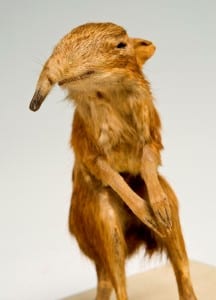
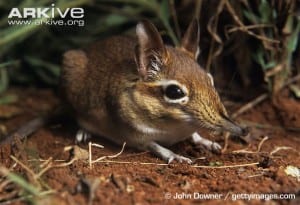

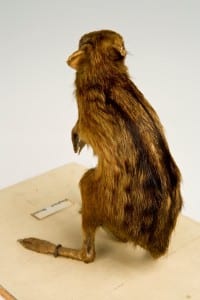
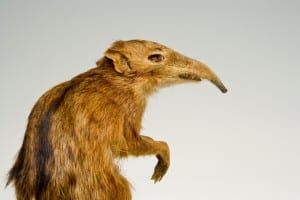
[…] […]